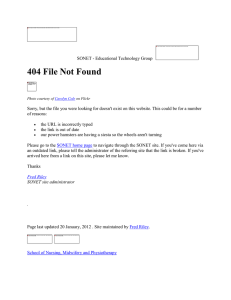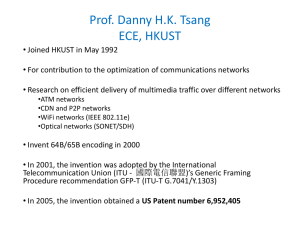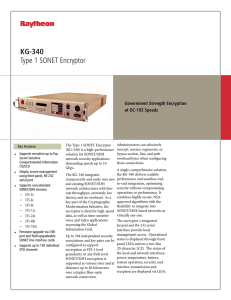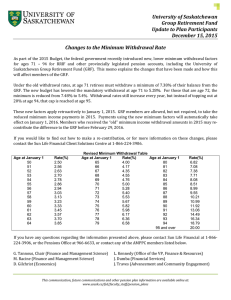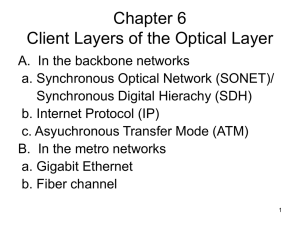Packet-over-SONET/SDH OC-3c/STM-1 Q Series Media Card
advertisement
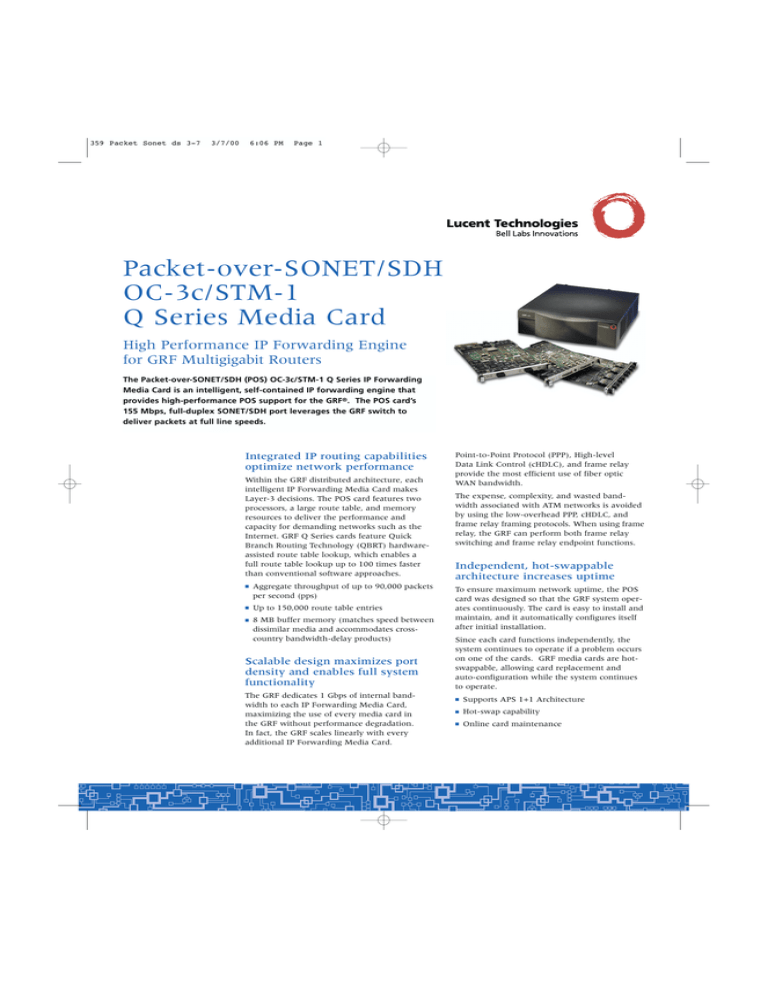
359 Packet Sonet ds 3-7 3/7/00 6:06 PM Page 1 Packet-over-SONET/SDH OC-3c/STM-1 Q Series Media Card High Performance IP Forwarding Engine for GRF Multigigabit Routers The Packet-over-SONET/SDH (POS) OC-3c/STM-1 Q Series IP Forwarding Media Card is an intelligent, self-contained IP forwarding engine that provides high-performance POS support for the GRF®. The POS card’s 155 Mbps, full-duplex SONET/SDH port leverages the GRF switch to deliver packets at full line speeds. Integrated IP routing capabilities optimize network performance Within the GRF distributed architecture, each intelligent IP Forwarding Media Card makes Layer-3 decisions. The POS card features two processors, a large route table, and memory resources to deliver the performance and capacity for demanding networks such as the Internet. GRF Q Series cards feature Quick Branch Routing Technology (QBRT) hardwareassisted route table lookup, which enables a full route table lookup up to 100 times faster than conventional software approaches. ■ Aggregate throughput of up to 90,000 packets per second (pps) ■ Up to 150,000 route table entries ■ 8 MB buffer memory (matches speed between dissimilar media and accommodates crosscountry bandwidth-delay products) Scalable design maximizes port density and enables full system functionality The GRF dedicates 1 Gbps of internal bandwidth to each IP Forwarding Media Card, maximizing the use of every media card in the GRF without performance degradation. In fact, the GRF scales linearly with every additional IP Forwarding Media Card. Point-to-Point Protocol (PPP), High-level Data Link Control (cHDLC), and frame relay provide the most efficient use of fiber optic WAN bandwidth. The expense, complexity, and wasted bandwidth associated with ATM networks is avoided by using the low-overhead PPP, cHDLC, and frame relay framing protocols. When using frame relay, the GRF can perform both frame relay switching and frame relay endpoint functions. Independent, hot-swappable architecture increases uptime To ensure maximum network uptime, the POS card was designed so that the GRF system operates continuously. The card is easy to install and maintain, and it automatically configures itself after initial installation. Since each card functions independently, the system continues to operate if a problem occurs on one of the cards. GRF media cards are hotswappable, allowing card replacement and auto-configuration while the system continues to operate. ■ Supports APS 1+1 Architecture ■ Hot-swap capability ■ Online card maintenance 6:06 PM Page 2 SONET Back Panel SONET/SDH Architecture Switch Interface Embedded IP Forwarding Software IP/SONET OC-3c MM B RCV ACT XMT ACT LINK OK RCV ACT XMT ACT LINK OK Status/Activity LEDs PWR ON FAULT STAT 0 STAT 1 Packet-overSONET/SDH OC-3c/STM-1 Q Series Media Card 3/7/00 IP/SONET OC-3c MM 359 Packet Sonet ds 3-7 4 MB Intput Buffer Full Route Table 4 MB Output Buffer Hardware-Assisted Route Table Lookup SONET/SDH OC-3c/STM-1 Media Interface The software on the SONET/SDH card supports: ■ IP ■ PPP ■ Frame relay UNI, NNI ■ cHDLC ■ Inverse ARP Features Standard IP Routing Performs IP datagram forwarding, header validation and processing, ICMP processing Frame Relay Performs IP encapsulation Point-to-Point Protocol (PPP) Supports Link Quality Monitoring Supports Annex A, Annex D, LMI-Standard, and LMI-Disabled LCP and IPCP options: –Maximum receive unit –Quality protocol –Magic number –IP address Supports Inverse ARP Automatically adds PVCs via LMI (optional) Provides 128 logical interfaces per port, independently configurable as point-to-point (Single PVC) or multiaccess (multiple PVCs) Supports UNI and NNI signaling cHDLC Full-duplex, synchronous transfer mode Cisco-compatible SNMP Monitoring Traffic on the card is monitored by the SNMP agent, which can in turn be monitored by any SNMP manager MIBs include: MIB-II, PPP MIB, and the GRF enterprise MIB APS 1+1 Architecture Yes Hot-swap Capability Yes Specifications Transfer Rate 155 Mbps Interfaces Per Card 1 full-duplex OC-3c/STM-1 SONET/SDH Optical Input (avg) -32.5 dBm minimum, -8 dBm maximum(SM) -32.5 dBm minimum, -14 dBm maximum(MM) Spectral Width 7.7 nm maximum(SM) 120 nm typical, 200 nm maximum(MM) Supports APS 1+1 Architecture Optical Output (avg.) Card Dimensions 9 in x 16 in [22.9 cm x 40.6 cm] Cable Requirements Single-mode cables: 9/125 micron optical fiber -14 dBm minimum, -8 dBm maximum(SM) Card Weight ~2 lbs [0.9 kg] -19 dBm minimum, -14 dBm maximum(MM) Operating Requirements Temperature: 32-104˚F [0-40˚C] Physical Connectors Duplex SC transceivers Optical Wavelength 1,261 nm minimum, 1,310 nm typical, 1,360 nm maximum(SM) Relative Humidity: 10-90% (noncondensing) Connector Requirements Must meet JIS C 5973 standards 1,270 nm minimum, 1,310 nm typical, 1,380 nm maximum(MM) Multimode cables: 62.5/125 micron optical fiber LASER Components Class 1, 1,310 nm LASER diodes(SM) (SM) Single Mode (MM) Multimode Regulatory Compliance* To learn more, contact your Lucent Technologies Representative, Authorized Reseller, or Sales Agent. Or, visit our Web site. www.lucent.com Specifications subject to change without notice. © 2000 Lucent Technologies, Inc. Printed in the U.S.A. 02/00 • 01-33b Safety UL 1950 3rd edition EMI FCC Class A Immunity IEC 1000-4-2 ESD CSA 22.2 No. 950 CISPR 22 Class A IEC 1000-4-4 EFT EN60950 VCCI Class A TS001 AS/NZS 3548 IEC 1000-4-8 Power frequency mag. fields IEC 825 Safety of laser products IEC 61000-4-3 Radiated RF CFR 21, Subpart J, laser safety IEC 61000-4-6 Conducted disturbances by RF *Tested at System Level
